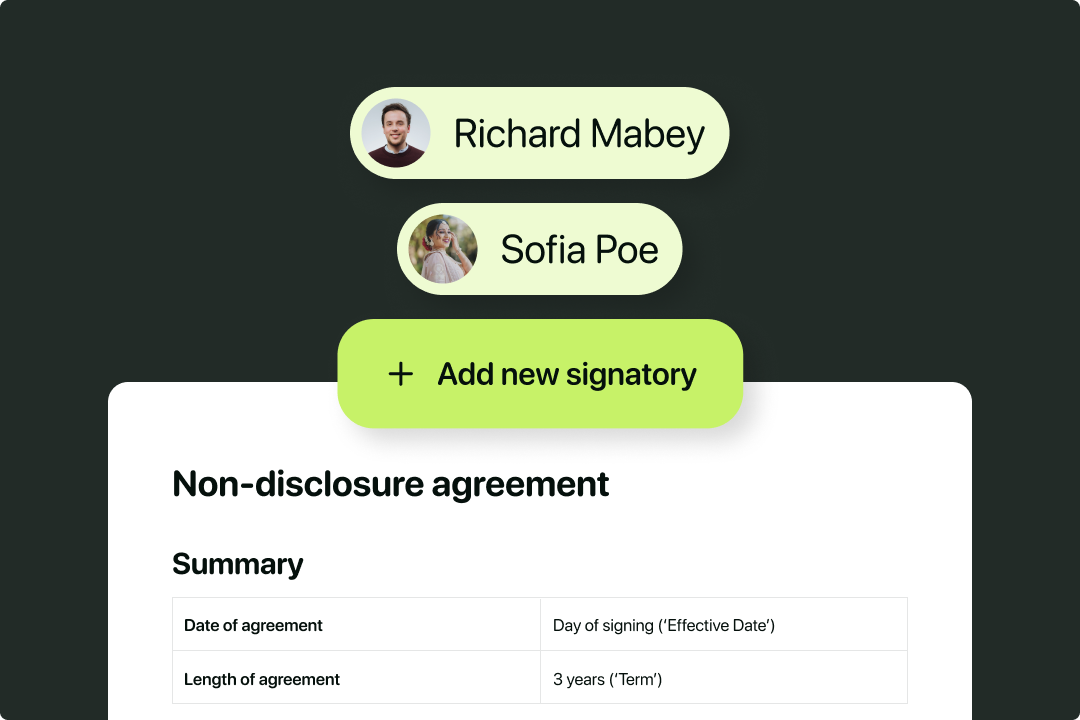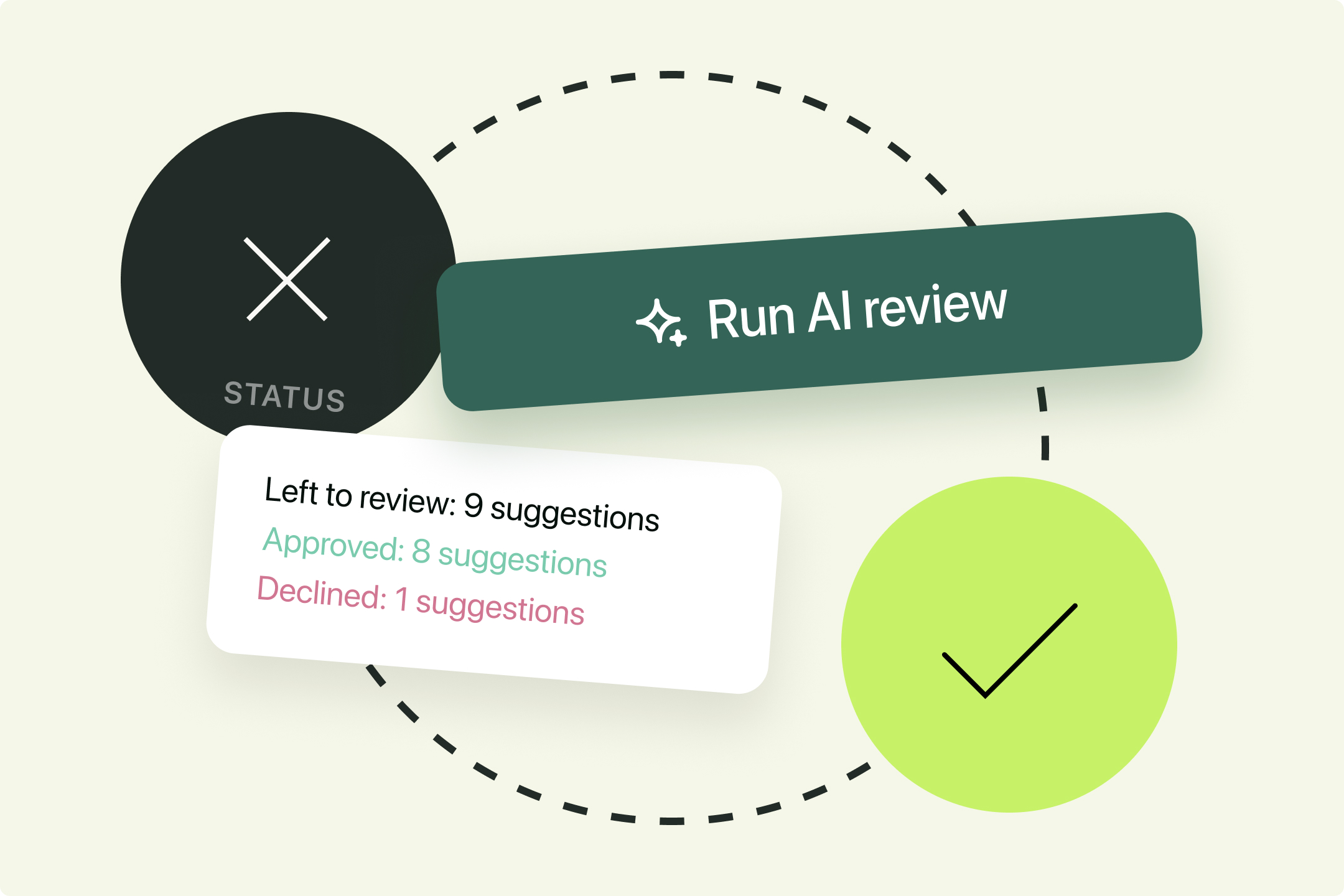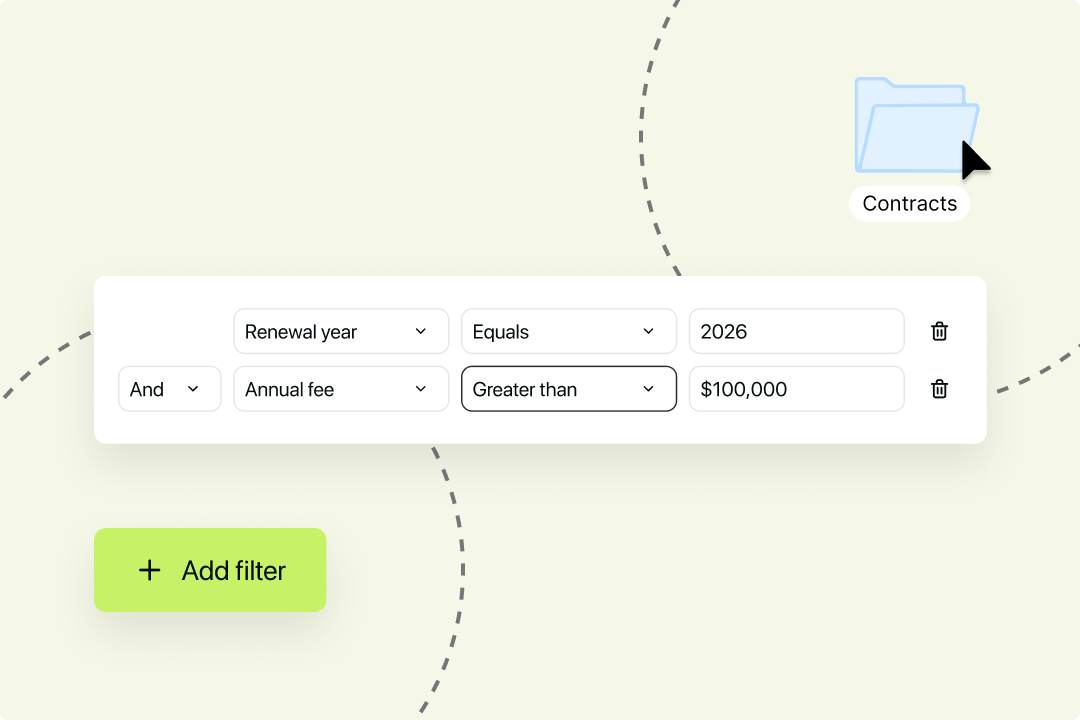Solutions
Customer Support
Resources
If you're running a fast-growth business, you will be making agreements with employees, customers, and vendors on a daily basis.
The primary purpose of a business contract is to document and formalize these agreements, which means turning a series of promises into a detailed (and legally binding) list of rights, rules, and obligations that both parties must follow.
Sounds complicated, right? Don’t stress. This post will explain what a business contract is, why they are so important, and all of the different types of business contracts you need to know about.
A business contract is a legally binding agreement between two or more parties that governs any transaction made in a business environment.
Typically, these business contracts will be drafted by either the buyer or the seller, and they will describe the specific terms of an agreement, such as: what is being promised by each party, when these promises need to be completed, what will be delivered, and when payment for these products and services will be due. These are also called the elements of a contract.
The definition of a business contract is broad, as legal agreements can be used in virtually all realms of business. Some examples of this include:
Now you know what a business contract is. But why do they matter?
Business contracts are important for any business, as they perform various different purposes. In fact, a recent study conducted by the IACCM found that there are a whole host of reasons why businesses use contracts, including that:

That’s not all, either. Contracts are also a perfect opportunity for businesses to demonstrate their professionalism, and that they care about the commitments they make.
In fact, contracts are a key touchpoint for business relationships, and they are an effective way to communicate with potential clients, partners, and employees. As a result, contracts also act as an extension of your company’s brand.
If contract process is proving to be a pain point for your business, it could be blocking your revenue and growth. To find out how to automate contract admin and win back time for high-value tasks, hit the button below to get in touch.
Business can be broken down into numerous functions, and business contracts can act in the same way. In fact, business contracts can typically be categorized in three ways:
Most business types of business contracts are bilateral contracts, too. This means that both parties have something to offer.
If you haven’t realized already, business agreements come in many shapes and sizes, with each performing a specific job or purpose. Let’s explore the most common types of business contracts, and how they work:
A lease agreement is an enforceable contract signed by both a landlord and a business tenant. This type of contract will grant the tenant the right to use a property for commercial purposes for a set period of time, in exchange for an agreed fee.
Unlike residential lease agreements, lease agreements for businesses tend to have less governmental protection, as the parties tend to be more business-savvy.
However, there are still various commercial lease obligations to follow when renting out a business property, and these should be clearly outlined in this type of business agreement.
Need help drafting real estate contracts? Check out these free property-related templates:
Consulting agreements are created when a client wants to obtain specialized services from a consultant in exchange for an agreed rate of compensation.
These types of business contracts will identify what services will be provided, what expenses can be reimbursed, and the amount of time that the consultant is expected to devote to the service - which is usually measured in hours, days, weeks, or months depending on the business’ needs.
Since this work is typically outsourced rather than completed in-house, it is not uncommon for consulting agreements to include confidentiality clauses, too.
Also known as distributor agreements, a distribution agreement is a contract between a supplier with a product to sell and a separate business that wants to market and sell this merchandise.
Under the terms of the contract, the distributor usually agrees to purchase products from the supplier and sell them to customers within a specific geographical area.
Reselling and distributing goods on behalf of another business? Check out these templates:

Marketing agreements are formal contracts between two or more parties that outline the terms and conditions for the promotion and sale of products or services. These are often for services outsourced to agencies or freelancers. However, they often include collaborations and partnerships, too.
Contracting for marketing services but not sure where to start? Check out these free templates:
A DPA is a legal document signed by a data controller and a data processor to ensure that the processor will handle the data provided by the controller in a way that complies with the General Data Protection Regulation (GDPR).
The DPA will outline the scope of the data, its purpose, and which other parties that will have access to the data.
Need help drafting your DPAs? We've got you covered for all things privacy and data protection:
Employment contracts are fairly self-explanatory. They are signed agreements between an employee and an employer that establishes the rights and responsibilities of each party for the duration of their relationship. As a result, they often vary in scope.
However, employment and HR contracts typically describe employment-related matters such as general responsibilities, salary, work schedules, confidentiality, and the duration of a person’s employment, to name a few. They may even outline terms around exclusivity. Offer letters can be binding contracts too.
Looking to make (and compensate) new hires? Check out these templates:
Amending employment terms for your team? Check out these free templates:
Parting ways with an employee? Use these free contract templates:
Other HR policy and contract templates:
A franchise agreement is used to establish a relationship between a franchisor and franchisee, and it gives franchisees various legal rights. These include:
Franchise agreements are a critical part of protecting a brand and the way it is represented, which is essential in business.
A letter of intent is a legal agreement used by two or more parties to express their intention to do business together. They are often drafted in the early stages of commercial relationships, and are used before a formal contract has been entered.
That said, they are similar to contracts in many ways. For example, like contracts, they often include the important roles and responsibilities of parties. These business contracts are designed to eliminate any pain points and bottlenecks when it comes to formalizing the agreement and move towards a more efficient contract workflow.
Under the terms of a licensing agreement, a property owner gives another party permission to use their brand, patent, or trademark.
These business documents provide details about the type of licensing agreement involved, the agreed terms of usage, how the licensor will be paid, and clarity that will prevent any future disputes relating to sales, royalties, and quality issues.

Want to save time drafting your licensing contracts? Check out these templates:
A membership agreement is a contract between a business and its customers (aka members) that outlines what is expected of both parties.
Whilst the specific details of a membership agreement will vary depending on the type of service on offer, it is fair to assume that this business agreement will provide details on the obligations of each party, any restrictions on use, the fees to be paid, and matters relating to privacy.
Like most business contracts, a membership agreement is designed to avoid misunderstandings and friction between a business and its customers.
Entertainment contracts are agreements used to define the terms and conditions between parties involved in the creation, production, and distribution of entertainment content.
These contracts cover aspects such as rights, compensation, and obligations for projects like films, music, and performances.
For example, a recording contract specifies the rights of a music label and artist, while a talent agreement outlines the terms between a production company and an actor.
Looking for entertainment contract templates? We’ve got you covered:
NDAs are commonly used in a commercial setting to protect sensitive information about a business, meaning they establish a confidential relationship between the signing parties.
Since NDAs are used so frequently in business, it is unsurprising that so many legal and business teams are seeking to digitize, scale and automate NDAs.
If you are looking to reduce the time your business spends on creating and negotiating confidentiality agreements, try our free NDA template.
When a buyer wants to purchase merchandise from a wholesaler, manufacturer, or retailer, they typically complete an order form. If executed well, this document will provide an organized, straightforward summary of a customer’s needs and expectations when placing an order.
Download this free order form template to make the ordering process faster and more efficient.
A purchase order is a business document that buyers provide to sellers to document the sale of products and services that will be delivered in the future.
Purchase orders benefit a customer since they can place their order with a supplier without the immediate need for payment. However, sellers also benefit from the knowledge that the buyer is legally required to make a payment upon delivery, so they are able to offer credit to buyers without any risk.
Looking to make the purchasing and procurement process much easier? Download this free purchase order template.
Software as a service (SaaS) agreements will lay down the terms and conditions of software delivery, whereby software and data are hosted centrally, with users accessing these over the internet.
Since the data is uploaded into a system and then saved in the cloud, no additional software or hardware is required in the SaaS model, and no physical goods are exchanged.

To find out more about how to manage SaaS agreements, check out this detailed guide to SaaS contract management.
We also have the following templates for you to use for free:
Sales contracts are among the most common types of business contracts. A sales contract is an agreement between a buyer and a seller that covers the sale and delivery of goods, securities, and other types of personal property.
According to the Uniform Commercial Code, a written sales contract should specify the parties involved, what will be sold, and any material or special terms or conditions. Some states also require that the amount and type of payment be specified within the contract.
Need help drafting a sales contract? Check out these free templates:
Construction contracts are agreements that outline the terms, conditions, and responsibilities for construction projects between the client and the contractor.
These contracts cover details such as project scope, timelines, costs, and quality standards. For example, a fixed-price contract specifies a set fee for the project, while a cost-plus contract reimburses the contractor for costs plus an agreed-upon profit margin.
Preparing for construction projects? Check out these free-to-download templates:
A share option agreement is a contract between the holder of stock shares and a third party that gives one party the right (but not the obligation!) to purchase or sell shares in the future at an agreed price.
This type of agreement will contain detailed terms regarding the shares, the option, and the circumstances in which the option can be exercised. If the share option is exercised, the other party is obliged to purchase or sell those shares and the purchaser has a contractual right to become a shareholder.
If you're looking for a way to generate option agreements quickly, check out our free Share Option Agreement template and Share Subscription Agreement (SSA) template.
Service level agreements are an essential part of any technology vendor contract, and they are used to define the service expected from a vendor. In particular, service level agreements will specify the metrics a service will be measured against, as well as the remedies available if the service falls short of these expectations.

A Statement of Work is a routine legal document in the world of project management that provides a detailed overview of a project’s requirements. This overview will typically include a breakdown of activities, deliverables, and timelines involved in a project, as well as details on pricing and other relevant regulatory conditions.
Need a robust SOW but not sure how or where to start? Download this free statement of work template. Sometimes people use a Memorandum of Agreement template for this purpose too.
Businesses often use contractor agreements when they outsource work to external teams. This type of business contract enables them to deliver on projects that they either don't have the capacity or expertise to complete in-house. This kind of agreement works well for consultants like fractional marketing or technical SEO experts.
Download your free independent contractor agreement template. If you're working with a freelancer, you can use this freelance agreement template instead.
Influencer agreements are put in place when a business wants an individual with a large or relevant following to promote their product or services. These can vary a lot depending on the scope of work required, but most will set out the compensation an influencer receives for their promotions, and what is required of them.
Hiring an influencer to promote your goods or services but not sure where to start? Download this free influencer agreement template.
Childcare agreements are another unique example of a business contract.
While they may not appear to fall into the commercial remit, it's common for daycare providers (usually businesses) to use a childcare agreement when onboarding new children.
Download this free childcare agreement template for your daycare business.
Business contracts aren't just about starting a new business relationship, they can also be used to swap parties into and out of an existing agreement.
Novation agreements are a great example of this as they enable one business to transfer their rights, responsibilities and obligations to a new party that wasn't previously involved in the contract.
Download this free novation agreement template to ensure a smooth transition for everyone involved.
Warranty agreements form a promise that the manufacturer or seller will replace a customer's defective goods within a certain period of time.
This is important for businesses selling physical goods, as it enables them to build trust with and reassure potential customers that they won't be left out of pocket for a product that doesn't work.
Not created a warranty agreement for your business yet? Use this free warranty agreement template to get started.
Royalty agreements are used to allow an individual to use a licensor's intellectual property in exchange for a compensation (known as a royalty).
This is just one example of a business contract used to protect and share intellectual property.
Need help managing your intellectual property? These contract templates can help:
Corporate agreements are contracts that establish the terms and conditions between businesses or within a corporation for various transactions and relationships.
These agreements cover areas such as mergers, acquisitions, joint ventures, and shareholder rights.
For example, a merger agreement outlines the terms for combining two companies, while a shareholder agreement specifies the rights and obligations of a company's shareholders.
Looking for corporate agreement templates? Check out the ones below:
Automotive contracts are agreements that define the terms and conditions between parties involved in the sale, lease, or maintenance of vehicles. These contracts cover aspects like payment terms, warranties, and service obligations.
For example, a vehicle lease agreement specifies the terms of leasing a car, while a service contract outlines the maintenance and repair services provided by a dealership.
Looking for contract templates for vehicle maintenance and sales? Check out these templates:

Finance agreements are contracts that establish the terms and conditions for financial transactions between parties. These agreements cover areas such as loans, investments, and credit arrangements.
For example, a loan agreement details the repayment terms and interest rates between a lender and borrower, while an investment agreement outlines the conditions under which funds are provided in exchange for equity or returns.
Looking to formalize payment terms and lending agreements? These templates can help:
The IACCM found that inefficient contract processes are costing businesses thousands. So why not automate the mundane aspects of contracting and spend more time on high-value work?
With Juro’s business contract templates, you can. Our contract templates provide a basic contract framework and enable your teams to self-serve with customisable fields for critical details like order dates, delivery requirements, warranties, and payment terms.
Juro has empowered more than 3000 business teams to streamline their routine contract workflow, and yours could be next. Juro is an all-in-one contract automation platform that helps visionary legal counsel and the teams they enable to agree and manage contracts in one unified workspace.
To supercharge your contract workflow with Juro, fill in the form below. Alternatively, hit the green button to get a personalized demo.
Lorem ipsum dolor sit amet, consectetur adipiscing elit. Suspendisse varius enim in eros elementum tristique. Duis cursus, mi quis viverra ornare, eros dolor interdum nulla, ut commodo diam libero vitae erat. Aenean faucibus nibh et justo cursus id rutrum lorem imperdiet. Nunc ut sem vitae risus tristique posuere.

